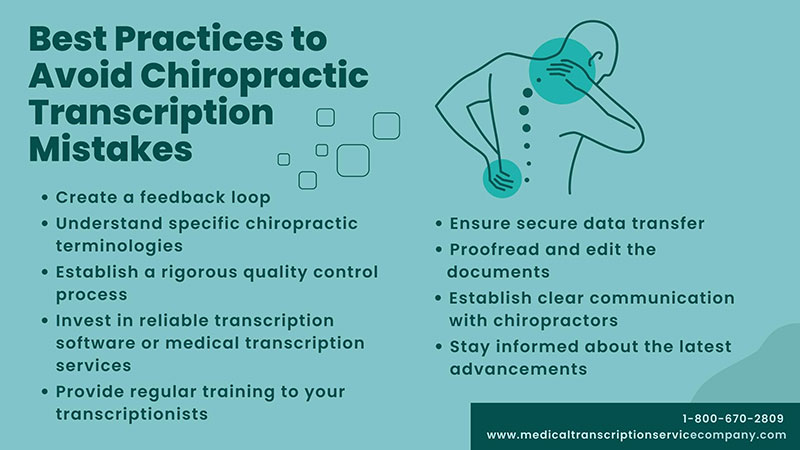
Chiropractors often encounter various challenges when it comes to transcription. The specialized terminology, intricate details of patient care, and time constraints make accurate and efficient transcription a demanding task. The risk of errors in transcribing chiropractic notes can lead to inaccuracies in patient records and compromise patient care. Moreover, many chiropractic practices don’t have the time and resources to dedicate to transcription. This is where outsourcing medical transcription can be highly beneficial.
Outsourcing ensures access to skilled transcriptionists familiar with chiropractic terminology, reducing the chances of errors. By entrusting transcription to specialized professionals, chiropractors can enhance the accuracy of their patient records, focus on their patients, and enhance the overall efficiency of their practice.

Chiropractic Transcription Mistakes and Prevention Solutions
Here are the common errors that can occur in transcribing chiropractic reports and specific steps you can take to address them:
Terminology errors
Chiropractic transcription terminology errors can lead to misunderstandings and inaccuracies in patient records. These errors can also impact patient safety and the quality of care provided. For instance, confusing “vertebra” with “vertebral,” or misinterpreting “subluxation” as “subduction” could result in serious misunderstandings. To mitigate terminology errors, transcriptionists must be well-versed in chiropractic terminology, use reliable medical references, and communicate closely with chiropractors to clarify any ambiguities. Employing skilled and experienced transcriptionists who understand the nuances of chiropractic language is vital to ensuring accurate and reliable patient records.
Misinterpretation of audio
Chiropractic care often involves detailed descriptions of patient conditions, treatments, and procedures. Failing to accurately capture spoken information from audio recordings can result in incorrect diagnoses, treatment plans, and patient histories being documented. For instance, mishearing “C2” as “T2” or misunderstanding the description of a manipulation technique can have serious consequences for patient care.
To prevent misinterpretation, transcriptionists should attentively listen to audio recordings multiple times, use quality headphones, and ensure a quiet environment during transcription. When encountering unclear or unfamiliar terms, reaching out to chiropractors for clarification is crucial. A meticulous and detail-oriented approach to transcribing audio is essential to maintaining the integrity of chiropractic patient records. Transcribers must listen carefully to the audio recordings multiple times. If certain parts are unclear, mark them as such and request clarification from the chiropractor or their staff.
Patient information mistakes
Accurate documentation of patient details such as names, birthdates, medical histories, and contact information is crucial for providing appropriate care. Errors like misspelled names, incorrect birthdates, or mixing up patient data can result in confusion, miscommunication, and potentially dangerous treatment decisions. For instance, confusing two patients with similar names could lead to treatments being administered to the wrong individual.
To prevent patient information mistakes, transcriptionists should double-check patient details against provided records and clarify any uncertainties with the healthcare provider. Implementing stringent quality control measures, proofreading, and cross-referencing patient data can significantly reduce the likelihood of such errors, ensuring accurate and safe chiropractic care. It is critical to double-check patient names, dates of birth, and other essential details to avoid any confusion.
Formatting inconsistencies
Maintaining a consistent and organized format is essential for clear communication among healthcare providers and accurate representation of patient information. Inconsistent formatting of headings, bullet points, lists, and paragraphs can hinder the readability and cohesiveness of the document. For example, varying font sizes, inconsistent use of abbreviations, or irregular indentation can make it challenging to navigate through the notes.
To prevent formatting inconsistencies, transcriptionists should adhere to a standardized formatting style or follow guidelines provided by the chiropractic practice. Developing a comprehensive style guide that covers font styles, heading structures, punctuation rules, and other formatting conventions can help maintain uniformity and clarity in chiropractic transcription documents. Regular proofreading and quality checks are also crucial to catch and rectify any formatting errors before finalizing the documents.
Abbreviation and acronym confusion
Chiropractic care often involves the use of specialized abbreviations and acronyms that hold specific meanings in the field. Misinterpreting or using incorrect abbreviations can alter the intended information and potentially impact patient treatment plans. For instance, confusing “ROM” (Range of Motion) with “ROM” (Read-Only Memory) could lead to incorrect documentation of a patient’s physical assessment.
To prevent abbreviation and acronym confusion, transcriptionists must be familiar with the abbreviations commonly used in the field. Cross-referencing with reliable medical resources and maintaining an updated list of chiropractic-specific abbreviations can help ensure accurate documentation. Regular communication with chiropractors to clarify any ambiguities or unfamiliar terms is essential to avoid errors arising from abbreviation and acronym confusion. It is ideal to create a comprehensive list of chiropractic abbreviations and acronyms and refer to it while transcribing. Avoid using unfamiliar abbreviations without clarification.
Lack of context
Chiropractic treatments often involve specific techniques, patient histories, and procedural details that need to be accurately transcribed to provide a comprehensive picture of the patient’s condition and treatment plan. Without proper context, transcribed notes might lack crucial information, leading to misunderstandings or incorrect treatment decisions. For example, a transcribed note about a “manipulation” might not clearly indicate which spinal segment was involved, potentially leading to confusion during subsequent visits.
To prevent the lack of context in chiropractic transcription, transcriptionists should:
- Listen carefully to the entire audio recording to capture the complete picture.
- Ask for additional information or clarification from chiropractors or their staff when details are unclear.
- Develop a strong understanding of chiropractic terminology and procedures to better comprehend the context.
- Ensure that transcribed notes include relevant patient history, treatment goals, and specific techniques used.
- Create a system for flagging or highlighting portions that require further context or verification.
Not researching new terminology
Failure to research new terminology can lead to outdated or incorrect documentation of patient care. Chiropractic specialty also evolves over time with new techniques, procedures, and terminology. Failing to stay updated with these changes can result in transcriptionists using obsolete terms or misunderstanding the latest terminology, which may compromise the accuracy and relevance of patient records. For instance, not being aware of a newly introduced chiropractic procedure might lead to misinterpretation during transcription.
It is important for transcriptionists to stay informed about the latest developments in chiropractic care through reputable medical sources, journals, and professional associations. They should also regularly update their knowledge of new terms, techniques, and guidelines in chiropractic practice.
By proactively addressing these common mistakes and implementing prevention strategies, medical transcriptionists can significantly improve the accuracy and quality transcripts. Outsourcing chiropractic transcription to an expert offers can prevent common mistakes and elevate the quality of patient documentation. Experts can ensure accurate interpretation of audio recordings, minimizing the risks of misinterpretation and terminology errors.
Outsourcing also allows chiropractors to focus their valuable time on patient care rather than the meticulous documentation tasks. In a professional medical transcription company, teams use advanced tools and quality control processes to ensure patient information accuracy and format consistency. They can ensure accurate and timely patient records, helping chiropractors deliver quality care. Ultimately, outsourcing chiropractic transcription optimizes efficiency, accuracy, and overall practice performance, while safeguarding against common transcription pitfalls.